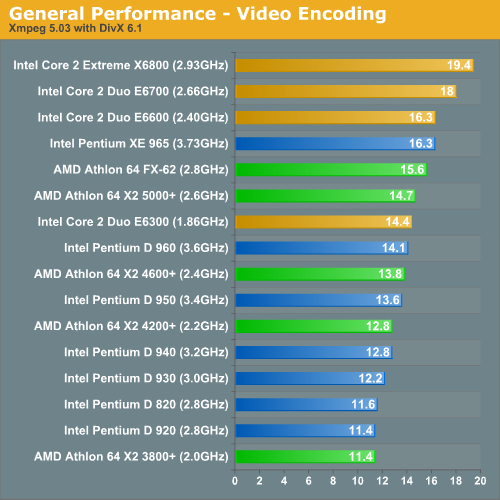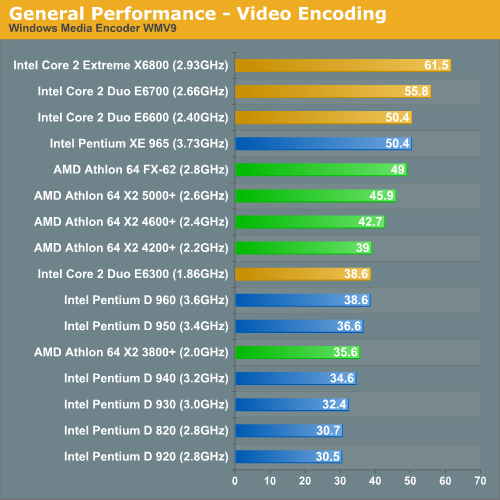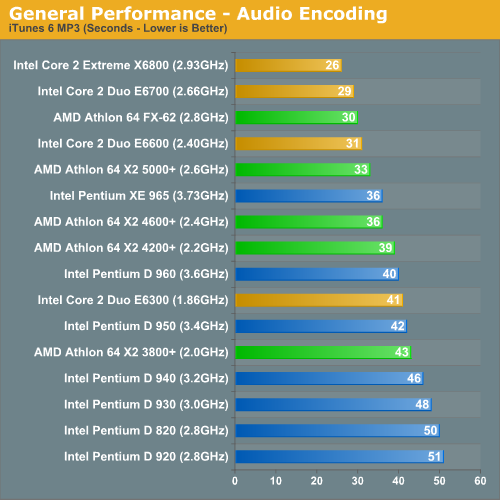Intel's Core 2 Extreme & Core 2 Duo: The Empire Strikes Back
by Anand Lal Shimpi on July 14, 2006 12:00 AM EST- Posted in
- CPUs
Encoding Performance using DivX 6.1, WME9, Quicktime (H.264) & iTunes
Multimedia encoding is typically a very good CPU benchmark, with performance that scales very nearly linearly with faster CPU clock speeds. Video testing was conducted using three popular codecs and applications: Xmpeg 5.03 with DivX 6.1, Windows Media Encoder with WMV9, and QuickTime 7.1 with H.264. The complexity of the encoding process increases as we move from DivX to WMV9, and H.264 encoding is in a league of its own in terms of the amount of CPU time required.



In something of a change, both the Core 2 Extreme and that E6300 manage roughly a 25% margin of victory over their AMD counterparts in the DivX test. The E6300 very nearly matches the X2 5000+ here. The X6800 maintains the 25% lead in WMV9, while the E6300 lead over the X2 3800+ drops to 8.5%, roughly equaling the 4200+. Finally, in H.264 encoding, the Core 2 Extreme claims one of its largest victories coming in 36% faster than the Athlon FX-62; the E6300 also manages a large 21% performance lead over the X2 3800+ and falls between the 4600+ and 5000+ in performance.

Moving over to audio encoding performance, we used Apple's iTunes 6 application to encode a single 307 MB Wav file into a 192kbps MP3. Audio encoding is still very CPU intensive, but of course the faster encoding times make the differences less noticeable in practical use. At the top and bottom price points, Intel leads again: 5% at the low-end, and 15% at the extreme performance segment. Unless you frequently encode really large amounts of audio files, however, it's unlikely you're going to notice Intel's 2-4 second lead.










202 Comments
View All Comments
Kougar - Friday, July 14, 2006 - link
I wasn't sure of the B2 Stepping 6 info because it has been impossible to find CPU-Z shots of this chip, let alone anyone reviewing them!!Mostly I just want to ensure Intel doesn't pull any surprises or OC limiting with them, at this point if the B2 Stepping 6 with that last round of bugfixing performs even the same as a Stepping 5 I'd be extremely happy!
redpriest_ - Friday, July 14, 2006 - link
Thanks Wesley - my Core 2 Duo Extreme X6800 is definitely a Stepping 6, Revision B2 Conroe. It has a packaging date of July 5, 2006. I have all the multipliers unlocked, and I am stuck at around 3.466 ghz using multipliers only for stability. I am running on the Intel 975X BadAxe rev 304 with the latest BIOS.I haven't tried upping the bus from there, yet - I am using 1.4 volts; default voltage isn't dual prime 95 stable at 3.466 ghz, but is at 3.2 ghz.
I haven't tried any intermediate voltages between there to test, so it's possible my Conroe is stable at 3.466 ghz at less voltage. I'll give that a try.
Kougar - Friday, July 14, 2006 - link
What motherboard is this? Have you double-checked your RAM settings and memory ratio? I'd imagine setting a 1:1 ratio, using the most relaxed timings, and slowly ramping up the FSB would get you further. And do try less voltages... ;)That's my plan anyway, DDR2-800 memory speeds on a 1:1 ratio thanks to a 400FSB, 10x multiplier... :)
Kougar - Friday, July 14, 2006 - link
Anandtech used Engineering Sample CPUs, so they would be B0 Stepping 4 or B1 Stepping 5 only. Only retail models will be B2 stepping 6...Did you change your cpu voltage any? Sounds like you didn't ;)
redpriest_ - Friday, July 14, 2006 - link
I had to - 1.4 (1.35 real) to get to 3.466, and 1.5 to 3.733.Wesley Fink - Friday, July 14, 2006 - link
Did you OC by adjusting multipliers first? We could run the X6800 at 3.46 at 13 multiplier using stock voltage, but using 315 bus times the stock 11 multiplier required a small voltage increase. The easiest OCs used higher multipliers and modest FSB increases. The E Conroes are locked, however, and can only be overclocked by increasing the FSB.redpriest_ - Friday, July 14, 2006 - link
Yes, I tried using multipliers only, I haven't fiddled with bus speed yet.Kougar - Friday, July 14, 2006 - link
First, the X6800 is selling at NewEgg, and they are price gouging it for all it's worth. Still listed in stock after having been up for 3+ hours...What a great way to start the day... Thank you Anandtech for this great article! Supurb! Now I have to agree with the poster above me, some info on the E6300 overclocking would about round out my curiosity!
I have a question though, do y'all or anyone else have some CPUZ shots of a retail shipping Conroe? I believe this are supposed to be revision B2 stepping 6??
As for the expected skeptics, my saying the numbers appear to jive won't mean anything... so I'll just say there are over 25 reviews out now of the Core 2 Duo released today. :)
mAdMaLuDaWg - Friday, July 14, 2006 - link
I'm curious on if you tried OCing the E6300. What was the highest stable speed you were able to get.xsilver - Monday, July 17, 2006 - link
for those who dont want to read the xbit labs articlethe overclocking of the e6300 is limited by the motherboard - eg. cant get the board to boot at any higher than 420mhz fsb
we may have to wait for nvidia's core2 solution to see higher fsb's